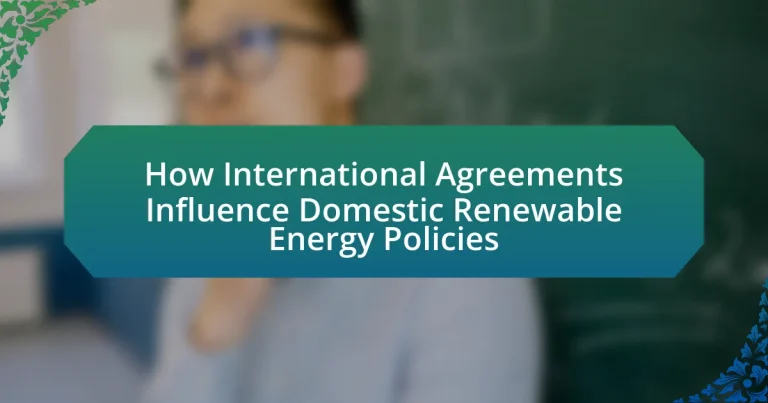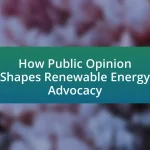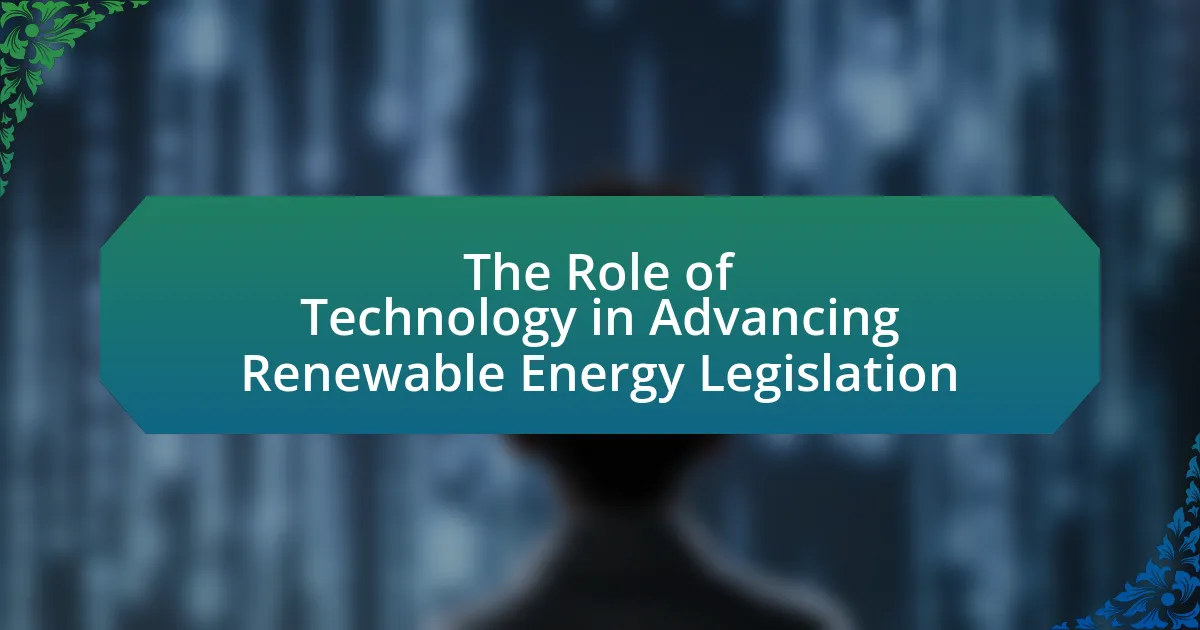The article examines how international agreements, such as the Paris Agreement and the United Nations Framework Convention on Climate Change, shape domestic renewable energy policies by establishing binding commitments that influence national legislation and investment priorities. It highlights the role of these agreements in driving countries to adopt renewable energy technologies and practices, as seen in Germany’s Energiewende policy. The article also discusses the challenges countries face in aligning domestic policies with international commitments, including conflicting national interests and economic factors, while emphasizing the importance of stakeholder engagement and innovative approaches to enhance policy effectiveness. Additionally, it outlines best practices for integrating international agreements into national frameworks to promote sustainable energy development.
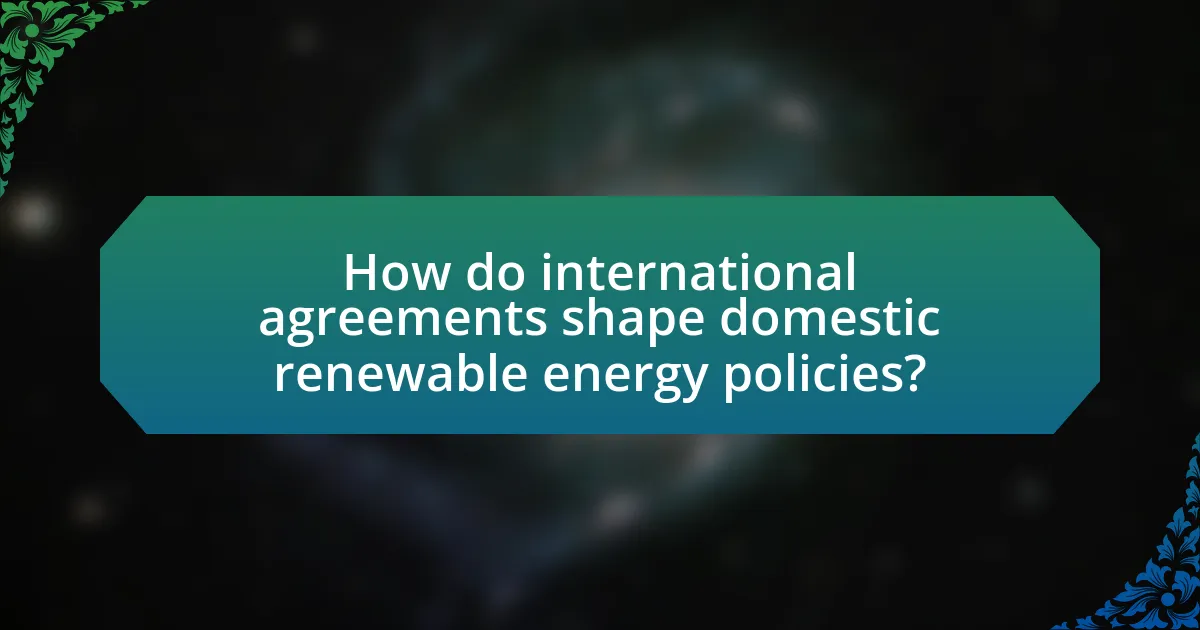
How do international agreements shape domestic renewable energy policies?
International agreements shape domestic renewable energy policies by establishing binding commitments and frameworks that countries must adhere to, influencing national legislation and investment priorities. For instance, the Paris Agreement compels signatory nations to set and achieve specific greenhouse gas reduction targets, which often leads to the development of policies promoting renewable energy sources. Countries like Germany have implemented the Energiewende policy, driven by international climate commitments, resulting in a significant increase in renewable energy production, which rose from 6% in 2000 to over 40% in 2020. This demonstrates how international agreements can directly impact domestic policy formulation and implementation, aligning national goals with global sustainability objectives.
What are the key international agreements influencing renewable energy?
The key international agreements influencing renewable energy include the Paris Agreement, the United Nations Framework Convention on Climate Change (UNFCCC), and the Sustainable Development Goals (SDGs). The Paris Agreement, adopted in 2015, aims to limit global warming to well below 2 degrees Celsius, encouraging countries to enhance their renewable energy commitments. The UNFCCC, established in 1992, provides a framework for international cooperation on climate change, promoting the transition to renewable energy sources. The SDGs, particularly Goal 7, emphasize the importance of ensuring access to affordable, reliable, sustainable, and modern energy for all, which drives national policies towards renewable energy development. These agreements collectively shape domestic policies by setting international standards and encouraging nations to adopt renewable energy technologies and practices.
How do agreements like the Paris Accord impact national energy strategies?
Agreements like the Paris Accord significantly influence national energy strategies by compelling countries to commit to specific greenhouse gas reduction targets, which often necessitates a shift towards renewable energy sources. For instance, the Paris Accord encourages nations to develop and implement policies that promote clean energy technologies, thereby reducing reliance on fossil fuels. As a result, countries like Germany have accelerated their transition to renewable energy through initiatives such as the Energiewende, which aims to increase the share of renewables in their energy mix to 80% by 2050. This alignment with international commitments not only drives domestic policy changes but also fosters investment in renewable energy infrastructure, as seen in the United States, where states have adopted renewable portfolio standards in response to federal climate agreements.
What role do trade agreements play in renewable energy development?
Trade agreements significantly facilitate renewable energy development by promoting cross-border investments, technology transfer, and regulatory harmonization. These agreements often include provisions that encourage the adoption of clean energy technologies and create a favorable environment for renewable energy projects. For instance, the Paris Agreement, which is a global framework, incentivizes countries to commit to renewable energy targets, thereby influencing domestic policies to align with international standards. Additionally, trade agreements can lower tariffs on renewable energy equipment, making it more economically viable for countries to invest in solar, wind, and other renewable sources. This economic incentive is supported by data showing that countries with favorable trade agreements experience faster growth in renewable energy capacity compared to those without such agreements.
Why are international commitments important for domestic policy?
International commitments are crucial for domestic policy because they establish binding frameworks that guide national legislation and regulatory practices. These commitments often reflect global standards and expectations, compelling countries to align their domestic policies with international norms, particularly in areas like renewable energy. For instance, the Paris Agreement requires signatory countries to set and achieve specific greenhouse gas reduction targets, which directly influences national energy policies and investment in renewable technologies. This alignment not only enhances a country’s credibility on the global stage but also fosters cooperation and access to international funding and technology transfers, thereby accelerating the transition to sustainable energy systems.
How do global targets affect national legislation on renewable energy?
Global targets significantly influence national legislation on renewable energy by establishing benchmarks that countries strive to meet. These targets, often set through international agreements like the Paris Agreement, compel nations to create or amend laws that promote renewable energy development, enhance energy efficiency, and reduce greenhouse gas emissions. For instance, countries that commit to specific emissions reduction goals are likely to implement policies that incentivize renewable energy investments, such as tax credits or subsidies for solar and wind energy projects. This alignment with global targets is evident in the European Union’s Renewable Energy Directive, which mandates member states to achieve a collective target of at least 32% renewable energy by 2030, thereby shaping national policies to support this objective.
What are the consequences of non-compliance with international agreements?
Non-compliance with international agreements can lead to diplomatic tensions, economic sanctions, and loss of credibility on the global stage. Countries that fail to adhere to agreements may face retaliatory measures from other nations, which can include trade restrictions or financial penalties. For instance, the United States’ withdrawal from the Paris Agreement in 2017 resulted in international criticism and diminished its influence in global climate negotiations. Additionally, non-compliance can hinder cooperation on critical issues such as climate change, as seen in the case of nations that do not meet their emissions targets, ultimately affecting global efforts to transition to renewable energy sources.
How do countries implement international agreements into their policies?
Countries implement international agreements into their policies by incorporating the terms and obligations of these agreements into their national legislation and regulatory frameworks. This process often involves a series of steps, including the ratification of the agreement by the national legislature, followed by the development of specific laws or regulations that align with the commitments made internationally. For instance, the Paris Agreement on climate change has led many countries to establish national climate action plans that set legally binding targets for greenhouse gas emissions reductions. These plans are often supported by policies that promote renewable energy development, such as subsidies, tax incentives, and investment in clean technology. The effectiveness of this implementation can be measured through progress reports submitted to international bodies, demonstrating compliance with the agreed-upon targets and commitments.
What processes are involved in translating international commitments into domestic laws?
The processes involved in translating international commitments into domestic laws include ratification, incorporation, and implementation. Ratification occurs when a country formally agrees to an international treaty, often requiring legislative approval. Incorporation involves adapting the treaty’s provisions into national legal frameworks, which may necessitate drafting new laws or amending existing ones. Implementation ensures that the incorporated laws are enforced and operationalized within the domestic legal system. For example, the Paris Agreement on climate change required countries to enact specific legislation to meet their greenhouse gas reduction targets, demonstrating how international commitments can directly influence national policy and legal structures.
How do stakeholders influence the implementation of these policies?
Stakeholders significantly influence the implementation of renewable energy policies by shaping decision-making processes and resource allocation. For instance, government agencies, private sector companies, and non-governmental organizations often collaborate to align their interests with international agreements, such as the Paris Agreement, which sets binding commitments for greenhouse gas reductions. This collaboration can lead to the establishment of supportive regulatory frameworks, financial incentives, and public awareness campaigns that facilitate the adoption of renewable energy technologies. Additionally, stakeholders can mobilize public opinion and lobby for policy changes, as seen in various countries where grassroots movements have successfully advocated for stronger renewable energy commitments, demonstrating the power of collective action in influencing policy outcomes.
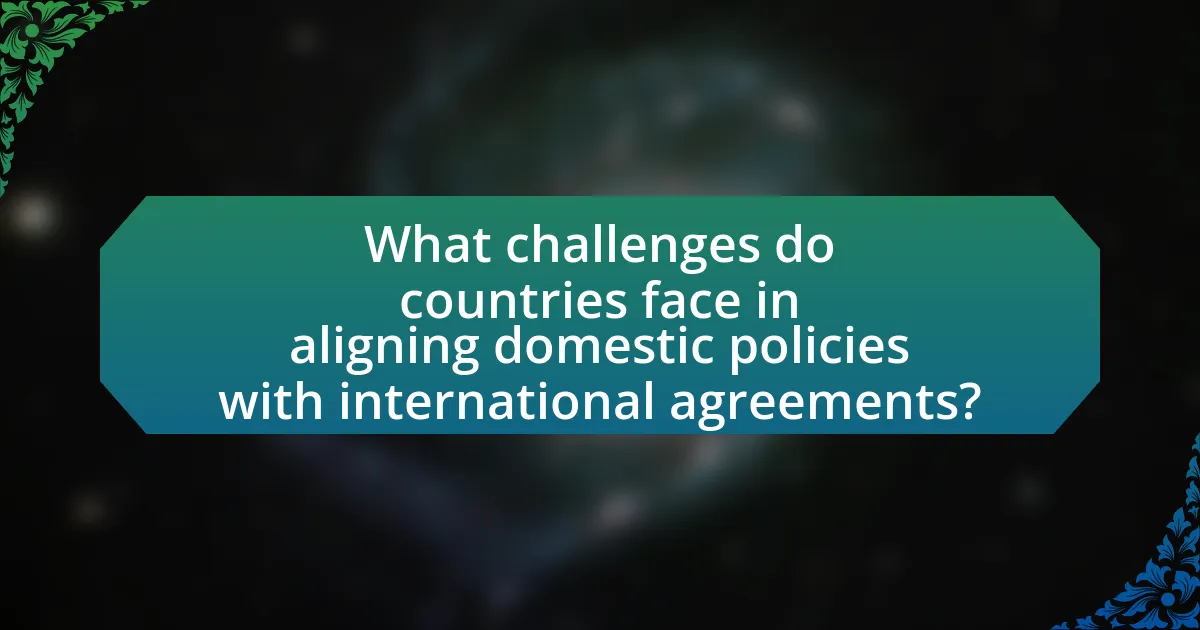
What challenges do countries face in aligning domestic policies with international agreements?
Countries face significant challenges in aligning domestic policies with international agreements, primarily due to conflicting national interests and varying levels of economic development. For instance, developed nations may prioritize environmental sustainability, while developing countries often focus on economic growth and poverty alleviation, leading to tensions in policy alignment. Additionally, the complexity of international agreements can create difficulties in interpretation and implementation at the national level, as seen in the Paris Agreement, where countries have different capacities and commitments. Furthermore, domestic political dynamics, such as changes in government or public opposition, can hinder the consistent application of international commitments, exemplified by the withdrawal of the United States from the Kyoto Protocol in 2001. These factors collectively complicate the process of harmonizing domestic policies with international obligations.
What are the common barriers to effective policy alignment?
Common barriers to effective policy alignment include conflicting interests among stakeholders, lack of coordination between different levels of government, and insufficient resources for implementation. Conflicting interests arise when various stakeholders, such as industry groups and environmental organizations, prioritize different outcomes, leading to resistance against unified policies. Lack of coordination occurs when federal, state, and local governments fail to communicate effectively, resulting in fragmented approaches that undermine overall policy goals. Insufficient resources, including funding and technical expertise, hinder the ability to implement and enforce policies effectively, as seen in various countries struggling to meet international commitments on renewable energy.
How do economic factors hinder the adoption of renewable energy policies?
Economic factors hinder the adoption of renewable energy policies primarily through high initial investment costs and market volatility. The transition to renewable energy often requires substantial upfront capital for infrastructure development, which can deter governments and private investors, especially in economies with limited financial resources. For instance, the International Renewable Energy Agency reported that global investment in renewable energy reached $282 billion in 2019, highlighting the significant financial commitment required. Additionally, fluctuating fossil fuel prices can create uncertainty in the energy market, making it difficult for renewable energy projects to compete. This volatility can lead to reduced investor confidence, further impeding the implementation of renewable energy policies.
What political challenges arise when implementing international agreements?
Political challenges that arise when implementing international agreements include conflicting national interests, domestic political opposition, and varying levels of commitment among signatory countries. Conflicting national interests can lead to reluctance in adopting measures that may be perceived as detrimental to a country’s economic or political stability. For instance, countries heavily reliant on fossil fuels may resist transitioning to renewable energy sources mandated by international agreements, fearing economic repercussions. Domestic political opposition often stems from differing ideologies or priorities among political parties, which can hinder the ratification and enforcement of agreements. Additionally, varying levels of commitment can create disparities in implementation, as some countries may prioritize compliance while others may not, leading to unequal progress and potential tensions among nations. These challenges complicate the effective integration of international agreements into domestic renewable energy policies.
How do differing national priorities affect policy alignment?
Differing national priorities significantly affect policy alignment by creating divergent interests that can hinder cooperation on international agreements. For instance, countries prioritizing economic growth may focus on fossil fuel development, while those emphasizing environmental sustainability advocate for renewable energy adoption. This divergence can lead to conflicting policy frameworks, as seen in the Paris Agreement negotiations, where nations like the United States and China had differing commitments based on their economic and environmental priorities. Consequently, such differences can result in inconsistent implementation of international agreements at the domestic level, impacting overall effectiveness in achieving global renewable energy goals.
What role does public opinion play in shaping renewable energy policies?
Public opinion significantly influences the development and implementation of renewable energy policies. When a substantial portion of the population expresses support for renewable energy initiatives, policymakers are more likely to prioritize these issues in legislative agendas. For instance, surveys indicate that in countries like Germany, where public support for renewable energy exceeds 80%, the government has enacted ambitious policies to transition to renewable sources, such as the Energiewende initiative. This demonstrates that public sentiment can drive political action and lead to the establishment of comprehensive renewable energy frameworks, aligning domestic policies with international commitments to reduce carbon emissions and promote sustainable energy solutions.
How do competing interests among stakeholders complicate policy implementation?
Competing interests among stakeholders complicate policy implementation by creating conflicts that hinder consensus and decision-making. For instance, in the context of renewable energy policies influenced by international agreements, stakeholders such as government agencies, private companies, and environmental groups often have divergent priorities. Government agencies may prioritize economic growth, while environmental groups focus on sustainability, leading to disagreements on policy direction. A study by the International Renewable Energy Agency (IRENA) highlights that conflicting interests can delay the adoption of renewable energy technologies, as seen in various countries where fossil fuel interests resist transitioning to cleaner energy sources. This resistance can result in fragmented policies that fail to achieve intended environmental and economic outcomes, demonstrating how stakeholder competition directly impacts the effectiveness of policy implementation.
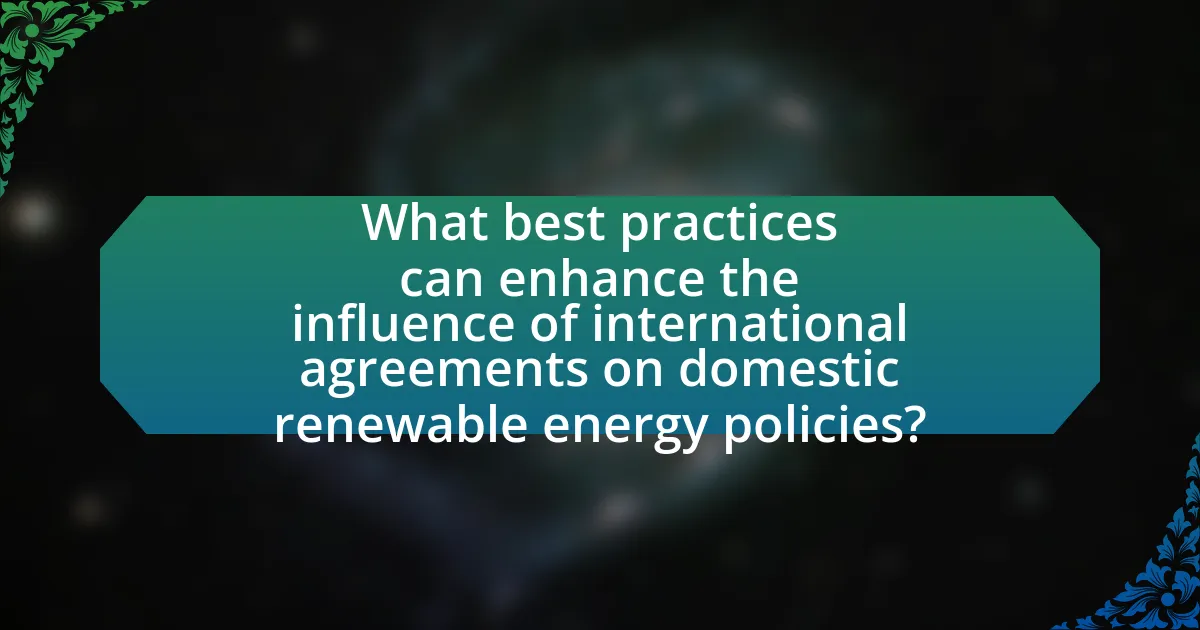
What best practices can enhance the influence of international agreements on domestic renewable energy policies?
Best practices that can enhance the influence of international agreements on domestic renewable energy policies include aligning national legislation with international commitments, fostering stakeholder engagement, and ensuring transparent reporting mechanisms. Aligning national legislation with international commitments ensures that domestic policies reflect the goals set in international agreements, such as the Paris Agreement, which aims to limit global warming. Fostering stakeholder engagement, including collaboration with local communities, businesses, and NGOs, promotes broader support and understanding of renewable energy initiatives. Transparent reporting mechanisms, such as regular progress updates and data sharing, build accountability and trust, encouraging compliance with international standards. These practices collectively strengthen the integration of international agreements into domestic renewable energy frameworks, leading to more effective policy implementation.
How can countries effectively engage stakeholders in the policy-making process?
Countries can effectively engage stakeholders in the policy-making process by implementing inclusive consultation mechanisms that ensure diverse voices are heard. This can be achieved through public forums, surveys, and stakeholder workshops that facilitate dialogue between government officials, industry representatives, and community members. For instance, the European Union’s Renewable Energy Directive emphasizes stakeholder engagement as a critical component, requiring member states to involve local communities and businesses in the development of renewable energy policies. This approach not only enhances transparency but also fosters trust and collaboration, leading to more effective and widely accepted policy outcomes.
What strategies can be employed to foster collaboration between government and industry?
To foster collaboration between government and industry, establishing public-private partnerships is essential. These partnerships can facilitate resource sharing, innovation, and joint projects that align with national energy goals. For instance, the U.S. Department of Energy has successfully collaborated with private companies through initiatives like the Clean Energy Manufacturing Initiative, which aims to enhance the competitiveness of the U.S. clean energy sector. Additionally, creating regulatory frameworks that incentivize investment in renewable energy can further strengthen this collaboration, as seen in countries like Germany, where feed-in tariffs have encouraged private sector participation in renewable energy projects.
How can public awareness campaigns support renewable energy initiatives?
Public awareness campaigns can significantly support renewable energy initiatives by educating the public about the benefits of renewable energy sources and fostering community engagement. These campaigns raise awareness about climate change, energy efficiency, and the economic advantages of transitioning to renewable energy, which can lead to increased public support for policies that promote renewable energy development. For instance, a study by the International Renewable Energy Agency (IRENA) found that informed communities are more likely to advocate for and adopt renewable energy solutions, resulting in a 20% increase in local renewable energy projects in regions with active awareness campaigns. This demonstrates that effective public awareness efforts can directly influence the success and implementation of renewable energy initiatives.
What lessons can be learned from successful policy implementations worldwide?
Successful policy implementations worldwide demonstrate the importance of stakeholder engagement and adaptability. For instance, the implementation of Germany’s Energiewende, which transitioned the country to renewable energy, involved extensive consultation with various stakeholders, including industry, environmental groups, and the public. This inclusive approach fostered broad support and facilitated smoother transitions. Additionally, the adaptability of policies, as seen in Denmark’s wind energy initiatives, which evolved based on technological advancements and market conditions, underscores the necessity of flexibility in policy frameworks. These examples illustrate that successful policies are characterized by collaboration and the ability to adjust to changing circumstances, leading to more effective and sustainable outcomes in renewable energy transitions.
Which countries have effectively integrated international agreements into their renewable energy policies?
Germany, Denmark, and Sweden have effectively integrated international agreements into their renewable energy policies. Germany’s Energiewende policy aligns with the Paris Agreement, aiming for a significant reduction in greenhouse gas emissions by transitioning to renewable energy sources. Denmark has committed to the European Union’s climate targets and has implemented policies that support wind energy, reflecting its obligations under international agreements. Sweden’s renewable energy strategy is also in line with the Paris Agreement, targeting a fossil-free energy system by 2040, showcasing its commitment to international climate goals.
What innovative approaches have been adopted to overcome challenges in policy alignment?
Innovative approaches adopted to overcome challenges in policy alignment include the establishment of multi-stakeholder platforms that facilitate dialogue between governments, private sectors, and civil society. These platforms enable collaborative decision-making and ensure that diverse perspectives are integrated into policy frameworks. For instance, the International Renewable Energy Agency (IRENA) has promoted the use of regional cooperation initiatives that align national policies with international commitments, enhancing coherence in renewable energy strategies. Additionally, the implementation of adaptive policy frameworks allows for flexibility and responsiveness to changing circumstances, which is crucial for aligning domestic policies with international agreements. These approaches have been validated by case studies demonstrating improved policy coherence and stakeholder engagement in various countries.
What practical steps can countries take to improve their renewable energy policies?
Countries can improve their renewable energy policies by implementing comprehensive regulatory frameworks that promote investment in renewable technologies. Establishing clear targets for renewable energy generation, such as the European Union’s goal of achieving at least 32% of energy from renewables by 2030, provides a structured approach for development. Additionally, countries should incentivize private sector participation through tax credits, subsidies, and grants, as seen in the United States with the Investment Tax Credit, which has significantly boosted solar energy installations. Furthermore, enhancing grid infrastructure to accommodate renewable sources and investing in research and development can facilitate the transition to cleaner energy. These steps are supported by evidence showing that nations with robust policies and incentives experience faster growth in renewable energy adoption and innovation.
